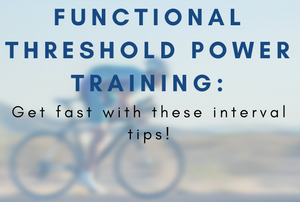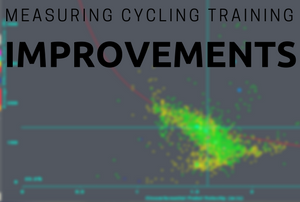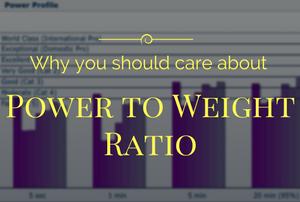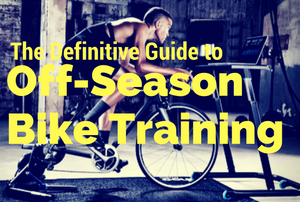
Functional threshold power intervals are the staple of any build program. While VO2 max is the genetic parameter that determines your body's upper limit of aerobic fitness, functional threshold is the parameter that determines how much (or what percentage) you can use.
How do you build Functional Threshold Power?
Functional Threshold Power really is what most people try to improve in a training program. While efficiency plays a role and VO2 max capacity is important, FTP is the big comparison number. Well, W/Kg really is the king, but FTP is the most well known and compared in amateur circles.
That said, how do we go about improving FTP? Well, you have to have the VO2 max ceiling first. Once you have that, the goal is to force your body to work right at or just above FTP to create endurance adaptations. You can do that in a number of different ways, each with their own outcomes.
Continue reading “Functional Threshold Power Training Intervals”

When a cyclist starts on a training program, there's an expectation that their training will yield improvements. They should get faster, climb better, become more efficient, or finish higher in the standings. But other than those end goals, how do you measure cycling training improvements in the middle of a training block? And more than that, why would you want to measure cycling training improvements during a training block?
Evaluating your training performance during a training block is hugely important to planning your next blocks of training. If you don't know how your current program is affecting your fitness, how can you adjust it to make further improvements? If you're not improving enough or worse, detraining due to lack of volume or intensity, you need to know that as soon as possible.
Additionally, measuring your improvement during a training block will give you a good idea where you stand in relation to your goals. If your power numbers are way down or your aerobic decoupling is poor, you know there's work to do before you can be competitive. It's sort of a benchmark on the path to your benchmark.
With the “why” out of the way, let's get down to the “how”. Click through the jump to listen to this episode of the Tailwind Coaching Podcast and learn how to measure cycling training improvements in a ton of different ways.
Continue reading “How to Measure Cycling Training Improvements”

As a cyclist finishes their base training, it's important to evaluate how strong your aerobic base truly is. By using a metric called “aerobic decoupling” you can quickly and easily determine if your base work was effective and if you're ready to progress into harder high-intensity interval training. But before you can evaluate your aerobic fitness, you need to learn what aerobic decoupling is and how to use it effectively.
What is aerobic decoupling and why do we care about it?
If you're training with power, aerobic decoupling is a key measurement to evaluate as you perform base training. Aerobic decoupling is a numerical measurement of aerobic efficiency and endurance. It's representative of your body's ability to process oxygen and produce energy (as detailed in Biohacking Energy Systems) and is a marker of overall aerobic fitness.
Before you can appreciate the value of aerobic decoupling, here's a refresher about how your body produces aerobic energy and the concept of heart rate drift.
To produce energy, your body takes in oxygen through the lungs and passes it to working muscles via the blood stream. Oxygen and a fuel (fat, protein or sugars) are processed in the mitochondria to create Adenosine Triphosphate (ATP). ATP is the actual energy molecule that allows your muscles to contract and create pedaling force. Constant demands on the aerobic energy system can create a phenomenon known as heart rate drift.
Click through the jump to read the show notes for episode 78 of the Tailwind Coaching Podcast:
Podcast: Play in new window | Download (Duration: 46:53 — 33.6MB)
Subscribe:

Watts per kilogram is an important measurement in determining your cycling potential. On the surface, it's a simple measurement, but it can give a ton of information about your performance and strengths. But what exactly can you learn about your cycling by looking at your W/Kg measurements? In this article you'll learn what W/Kg is, how to use it effectively to plan and execute your training and a couple ways to improve your power to weight ratio.
What is “watts per kilogram” and why does it matter?
Watts per kilogram, often abbreviated W/Kg is a measure of power to weight. It takes the amount of power you produce at various time periods and divides it by how heavy you are. Sounds pretty simple, right? In theory, it is. But like everything in your cycling training, there's more to it than just a number. Click through to learn a little bit more and figure out why W/Kg is so important.
Continue reading “Why Do Watts Per Kilogram Matter?”

If you're a cyclist looking to improve your performance, winter is the perfect time to adjust your bike training routine for the coming season. You can get your plan for next season down and start attacking your goals and objectives early. And by starting early, you can ensure you don't panic as you get closer to your season targets.
The thing to remember is that your offseason isn't a mashup of cross training, strength training and riding. All of your training should be carefully evaluated and scheduled to maximize the effectiveness of each workout. In order to do that, you need to get your off-season preparation started NOW.
Click through the break and I'll show you how to get started on building your most effective off-season bike training program ever!
Continue reading “The Ultimate Guide To Off Season Bike Training”




